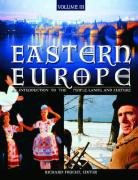Eastern Europe An Introduction to the People Lands and Culture 1st Edition by Richard Frucht ISBN 1576078000 9781576078006 by Richard Frucht 1576078000, 9781576078006 instant download after payment.
Eastern Europe An Introduction to the People Lands and Culture 1st Edition by Richard Frucht - Ebook PDF Instant Download/Delivery: 1576078000, 9781576078006
Full download Eastern Europe An Introduction to the People Lands and Culture 1st Edition after payment

Product details:
ISBN 10: 1576078000
ISBN 13: 9781576078006
Author: Richard Frucht
Eastern Europe: An Introduction to the People, Lands, and Culture sheds light on modern-day life in the 16 nations comprising Eastern Europe. Going beyond the history and politics already well documented in other works, this unique three-volume series explores the social and cultural aspects of a region often ignored in books and curricula on Western civilization.
The volumes are organized by geographic proximity and commonality in historical development, allowing the countries to be both studied individually and juxtaposed against others in the region. The first volume covers the northern tier of states, the second looks at lands that were once part of the Hapsburg empire, and the third examines the Balkan states. Each chapter profiles a single country—its geography, history, political development, economy, and culture—and gives readers a glimpse of the challenges that lie ahead. Vignettes on various topics of interest illuminate the unique character of each country.
Eastern Europe An Introduction to the People Lands and Culture 1st Table of contents:
Part I: Historical Foundations and Shaping Forces
- Chapter 1: The Historical Tapestry: From Ancient Times to Empires
- Early Migrations and Settlements: Slavs, Magyars, Balts
- Medieval Kingdoms and Powers (e.g., Poland, Bohemia, Hungary, Kievan Rus')
- The Influence of Byzantium and the Ottoman Empire
- Habsburg and Russian Imperial Dominance
- The Rise of Nationalism and the Idea of Nation-States
- Chapter 2: The Tumult of the 20th Century
- World Wars and the Collapse of Empires
- The Interwar Period: New States and Old Tensions
- The Cold War Era: Soviet Hegemony and the Iron Curtain
- Socialism in Practice: Central Planning and State Control
- Resistance, Dissent, and the Path to 1989
- Chapter 3: Post-1989 Transformations: Democracy and Transition
- The Fall of Communism and the Velvet Revolutions
- Building Democratic Institutions: Challenges and Successes
- Economic Liberalization and Market Economies
- Integration into Euro-Atlantic Structures: EU and NATO Expansion
- The Lingering Legacies of the Past
Part II: Lands and Environments
- Chapter 4: The Diverse Landscapes of Eastern Europe
- Major Geographical Features: Plains, Mountains (Carpathians, Balkans), Rivers (Danube, Vistula)
- Climate Zones and Their Variations
- Natural Resources and Environmental Challenges (e.g., pollution, deforestation)
- The Role of Geography in Historical Development
- Chapter 5: Urban and Rural Spaces
- Major Cities: Historical Development and Contemporary Character (e.g., Prague, Warsaw, Budapest, Bucharest)
- Urbanization Trends and Challenges
- Rural Life: Agriculture, Traditional Lifestyles, and Depopulation
- Infrastructure Development and Connectivity
Part III: People and Societies
- Chapter 6: Demography and Population Dynamics
- Population Trends: Decline, Aging, and Emigration
- Migration Patterns and Remittances
- Urban-Rural Disparities
- Chapter 7: Ethnicities, Languages, and Minorities
- Major Ethnic Groups and Their Distribution
- Linguistic Diversity: Slavic, Finno-Ugric, Romance, Germanic Languages
- Minority Rights and Inter-Ethnic Relations
- The Roma Community: Challenges and Contributions
- Chapter 8: Religions and Belief Systems
- Orthodox Christianity: History, Practices, and Influence
- Roman Catholicism: Its Role in Central Europe
- Protestantism, Judaism, and Islam in the Region
- Secularism and Religious Revival
- Chapter 9: Social Structures and Everyday Life
- Family Structures and Gender Roles
- Education Systems and Social Mobility
- Healthcare Challenges and Reforms
- Social Capital and Civil Society Development
Part IV: Culture and Expressions
- Chapter 10: Literature and Philosophy
- From Oral Traditions to National Epics
- Key Literary Movements and Authors (e.g., Romanticism, Realism, Dissident Literature)
- Nobel Laureates and Their Contributions
- Philosophical Traditions and Debates
- Chapter 11: Arts, Music, and Performance
- Visual Arts: Architecture, Painting, Sculpture (Folk Art to Avant-Garde)
- Classical Music and Composers
- Folk Music and Dance Traditions
- Cinema, Theatre, and Contemporary Art Scenes
- Chapter 12: Folklore, Customs, and Celebrations
- Oral Traditions: Myths, Legends, Fairy Tales
- Traditional Dress and Crafts
- Major Holidays and Festivals (Religious and Secular)
- Everyday Customs and Social Etiquette
- Chapter 13: Cuisine and Culinary Traditions
- Regional Specialities and Staple Foods
- The Influence of Historical Empires on Cuisine
- Drinks: Beer, Wine, Spirits
- The Role of Food in Social Gatherings and Identity
Part V: Contemporary Challenges and Future Prospects
- Chapter 14: Key Challenges Facing Eastern Europe
- Corruption and Governance Issues
- Populism and Democratic Backsliding
- Geopolitical Tensions and External Influences (e.g., Russia)
- Economic Disparities and Brain Drain
- Environmental Concerns and Sustainable Development
- Chapter 15: Eastern Europe in the 21st Century: Aspirations and Reality
- The Role of the Region in the European Union
- Innovation, Technology, and Economic Growth
- Preserving Cultural Heritage in a Globalized World
- Future Trajectories and Unforeseen Developments
People also search for Eastern Europe An Introduction to the People Lands and Culture 1st:
eastern europe an introduction to the people lands and culture
eastern european countries beginning with a
eastern european authors
eastern europe and northern asia
europe introduction
Tags: Richard Frucht, Eastern, People



